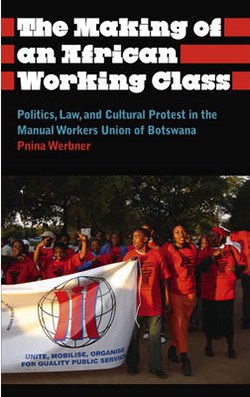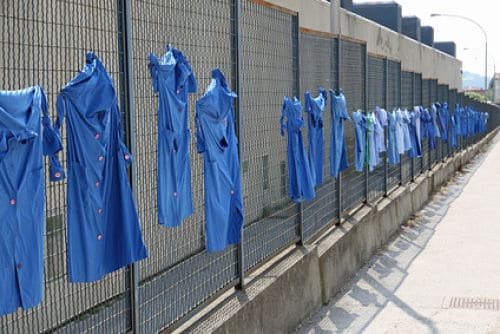An ethnography of class identity and consciousness, its origins and its component dynamics, is a tall order. After all, it is not a straightforward endeavor to say with certainty when a class identity becomes a potent political reality. When E.P. Thompson wrote The Making of the English Working Class, he had the benefit of a few generations of perspective between him and the start of his object of study. Indeed, even given years of government retrenchment and the rise of finance and service in Britain, as of 2011, 22% of Britons still identify as working class (Clery, Lee, and Kunz 2013, p. 4). The long view helps. All this is to say that as an ethnographer, Pnina Werbner has an unusually difficult empirical task. Hers is not to simply show a particular meaning or symbol system, or a static identity.
She is arguing for the emergence of a new solidarity in Botswana – that of a working class.
She does so by means of a ‘detailed case study of a blue collar, industrial-class, public service union…the MWU’ (p. 2). Once Werbner develops the case of the union in chapters 1-9, we see the union in action in 2011 during the ‘The Mother of All Strikes’ (p. 169) in chapters 10 and 11. The book ends with the strike’s afterlife as the union and government orbit each other like suns in a binary star system in an endless series of legal appeals.

It’s not just the subject matter that is overwhelming; it’s also the variety of intellectual conversations that the book enters into. At varying times, Werbner has something to say about ‘modern discourses…of class oppression, normative cosmopolitanism, labour rights, human rights and contemporary Christian humanist religiosity,’ (p. 59); Schism and Continuity in social life (2014: 96); as well as theology and class formation (pp. 142-143). All of these strands of scholarship inform the study of unions; in the run up to the strike it is unclear how all of this hangs together.
The strike itself in Chapter 10 is the linchpin of the book and a gem of ethnographic analysis, making ample use of abundant symbolism and recombinant and complicated cultural forms.
The reader sees and hears ‘nearly 100,000 public service trade unionists, [united across class lines], [singing] songs of rebellion’ (p. 169). And what songs they are! They ‘[contain] satirical comments on the current catastrophic state of workers household economies’ (p. 178), and ‘lampoon the wealthy upper crust for living it up while the workers do not have money to buy basic essentials’ (p. 185). All this is the more remarkable as in Botswana ‘verbal insults are illegal’ (p. 185). Chapter 10 is also the point at which a plot unfolds. Mass mobilization and a new vernacular of protest songs set the stage for a national allegorical confrontation between striking workers and the state. In this case strikers demand to meet with President Ian Khama (p. 173). Werbner portrays Khama as a readymade authoritarian villain, saying that ‘he seemed to disdain government workers, the very people who made Botswana an orderly, transparent, functioning democracy’ (p. 198; see also p. 206).
The strike ends in disappointment. Werbner notes that the government ‘used the strike to ‘retrench industrial class workers, replacing those dismissed…with employees of contract firms, without even the usual requirements to negotiate an exit package’ (2014: 199). The remainder of the book is taken up with a post-mortem of the strike (chapter 11), and the odd legal twilight of court cases and appeals, aptly referred to as ‘the Carnival of the Law’ (2014: 225). Again, the sequence of court cases move around issues such as the right to strike and the responsibilities of natural law.
I couldn’t help but be struck by the simultaneous erudition and deeply felt reporting in Werbner’s account of the MWU, but also by how diffuse it could all seem, especially in the lead up to the strike. It wasn’t clear what the book was building towards, or what pieces of the assemblage were critical, until the strike came and went. It’s also worth noting that every time character and plot crept into this book, the narrative and analysis became more coherent and compelling – whether it was the biography of a charismatic union leader, or the scrappy female union advocates.
In a far different context, Thomas Pynchon took stock of his early stories, most of which embarrassed him. In ‘Entropy’, he noted ‘a procedural error beginning writers are always being cautioned against. It is simply wrong to begin with a theme, symbol or other abstract unifying agent, and then try to force characters and events to conform to it’ (1984 p 12). In the case of The Making of an African Working Class, it’s not so much that there is one theme and things are jammed into it. Rather, there are a multiplicity of loose ends and scattered splashes into pools of scholarship, few of which clearly prefigure the big moment, when some sort of new class solidarity obviously seems to take shape. This is a common academic tactic: enter into any and all debates that seem relevant, and argue your point by overwhelming the reader with data and the symbolic capital of eclectic theoretical citations. The problem with this approach is that it can suffocate the plot.
There is no doubt that legal theory, agency theory, schism and continuity, comparative labour movements, a historical analysis, a symbolic analysis, and so on, can all say useful and fruitful things about the new solidarity in Botswana. Yet it’s unclear what good they do piled up and competing.
The Making of an African Working Class is an impressive book. I’m sure it will be essential reading in labour studies, studies of class formation, and studies of nation formation in Botswana. I also suspect that if and when the new working class stabilises and takes on a coherence, a clearer plot will emerge. It seems, though, for now, we are left spinning plates (nine in this case) whilst waiting for the story to start.
Clery, Elizabeth, Lucy Lee and Sarah Kunz. 2013. Public attitudes to poverty and welfare, 1983-2011.
Pynchon, Thomas. 1984. Slow Learner: Early Stories Boston: Little Brown and Co.
Werbner, Pnina. 2014. The Making of an African Working Class: Politics, Law, and Cultural Protest in the Manual Workers’ Union of Botswana. London: Pluto Press. 320 pp. Pb: £20.50. ISBN 978-0-7453-3495-0.








